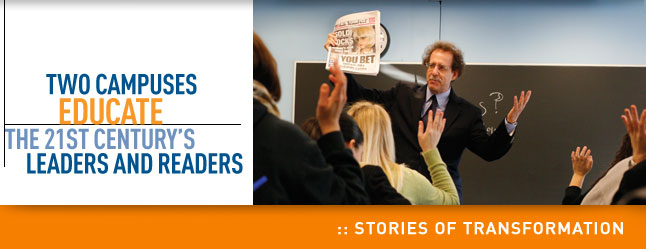
Two Campuses Educate the 21st Century’s Leaders and Readers
Article from the 2006 Knight Foundation Annual Report
The digital revolution is not for the faint of heart. At Columbia University’s prestigious Graduate School of Journalism, Dean Nicholas Lemann bridges the practice and teaching of journalism, on campus and in the field. The New Yorker writer is leading a high-profile effort to develop a series of real-world, multimedia case studies to teach the next generation of journalism’s editors and producers how to lead in a time of change.
“How do you teach a student how to be an editor of a big-city daily?” he asks. “How do you teach how to cover national security or ethical problems that come up in news stories?”
The cases are emerging from some of the timeliest and most complex stories in today’s headlines. They’re set in the newsrooms of, for example, The Times-Picayune in New Orleans during Hurricane Katrina, or The Washington Post.
“It is a much more powerful learning tool than if you brought in [Post Executive Editor] Len Downie and he said, ‘let me tell you how I do my job,'” says Lemann. “You’re inside something that happened in the real world of journalism that you cannot get to as a journalism student on the streets of New York.”
The Ivy League school is also one of the leaders of the Carnegie-Knight Initiative, an effort to bring the best of the academy into partnership with journalism educators. And Columbia students participate in the News 21 project, demonstrating that young journalists can produce top-notch specialized journalism for news outlets like the Associated Press, ABC, “Frontline” and The New York Times.
“What we hope to be able to do is to give journalists much more confidence, so they can look at a complicated subject, learn some of the substance themselves, and learn how to communicate it clearly,” says Lemann.
“On one hand, we need to tell stories rapidly through the media; at the same time people want what they’ve always wanted, and that’s meaning,” says Eric Newton, Knight’s vice president/Journalism Program. “Citizens want context. Nick is producing journalists who can do it at Columbia.
Sixty miles east of the city on Long Island, Howie Schneider, former editor-in-chief of Newsday, is leading the way as Stony Brook University adds to its journalism education mission another big experiment: educating a new generation of news consumers.
Schneider says quality journalism can’t survive without consumers who can recognize, appreciate and support it. The News Literacy course, ultimately reaching 10,000 Stony Brook undergrads, helps students develop what Schneider calls a new core competency for citizens in the 21st century.
“What makes a journalist?” asks Schneider. “Is Jon Stewart a journalist? Is Oprah Winfrey a journalist? What makes journalism different from other kinds of information, and how do you know when you see it?”
The students have seized the opportunity.
“I don’t think you can make an educated decision unless you know what the issues are,” says News Literacy student Adam Peck.
“If we can get an educated consumer population that can recognize the value of serious journalism, quality journalism, and understand how that’s different than junk journalism, whether they’re doctors or lawyers or teachers, I think News Literacy will be a crucial skill,” says Schneider.
“This is a time for people who can cross the divide from the 20th century of mass media,” says Newton. “It’s a time for great optimism about the real values of journalism, the values of fairness and accuracy and truth telling. That’s what we really care about. It’s about being able to intellectually separate those from all the nostalgia, and being able to take all those great values, that great core, and help move it into the new century.” For further information
Columbia University School of Journalism http://www.jrn.columbia.edu/
News 21 http://newsinitiative.org/
Nicholas Lemann biography http://www.jrn.columbia.edu/faculty/lemann.asp
Stony Brook University http://www.sunysb.edu/
Howard Schneider biography http://www.sunysb.edu/journalism/faculty.shtml